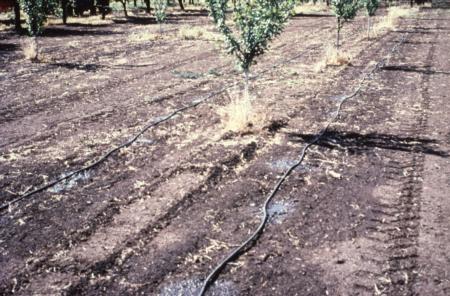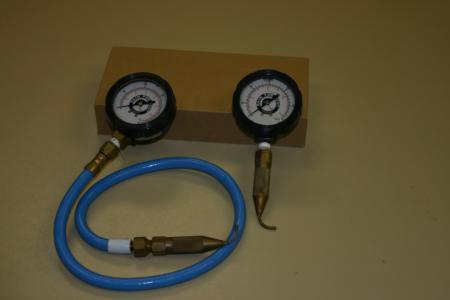Emitter Evaluations
Field self-evaluation of surface drip tubing systems

Prior to evaluating the system
The emitter sampling and pressure measurements should be taken when the drip system is operating without any obvious problems. Filters should be backwashed or cleaned, pipelines and lateral lines should be flushed, pressure regulators should be checked and adjusted (if needed), and any other necessary steps taken to ensure that the system is operating well.
Pressure measurements
Take water pressure measurements to give you a picture of the operating pressure throughout the drip system. Pressures should be taken from the head of the system to the system’s tail end, and from the lateral inlets to their tail ends. If pressures seem to vary significantly (in excess of 10 to 20%) within the system, more measurements are warranted. With consistent pressures within the system, you will be able to minimize the number of measurements you need to take.
Elevation change within the system will affect the system operating pressures. An elevation change of 2.3 feet will cause a 1 psi change in pressure. Make sure to gather pressure measurements in any areas where there are significant elevation differences.
Using a map, irrigation system layout plot, or written description, keep track of where each pressure measurement is collected. This information will come in handy when it comes time to evaluate the pressure and emitter discharge rate measurements.

How to take a pressure measurement
An accurate pressure gauge (liquid-filled or digital gauges work well), is critical to gathering good pressure measurements. Two easy access points that are generally available to measure pressure are at the head and tail ends of lateral lines. You can fit an appropriate drip fitting to the pressure gauge to facilitate measurement. To take a pressure measurement along a lateral, just punch a small hole in the drip tubing (just as you would to install a punch-in drip emitter), insert the tip of a pitot tube attached to the pressure gauge (see photo) into the hole, note the pressure, and then remove the gauge and plug the hole with a “goof plug.”
Choosing which drip emitters to sample for discharge
The objective in selecting emitters for sampling is to get measurements that are representative of all emitters in your system. This means gathering emitter discharge rates from the head of the system to the tail, from the head of the laterals to their tail ends. Make sure to get samples from any location that may have a different discharge rate – for example, high or low elevation locations or known areas of high or low pressure.
Measuring emitter discharge at locations where pressure measurements were taken is a good practice If a drip emitter’s discharge is higher or lower than expected, the first thing to check for is variations in pressure at the emitter. By coordinating pressure measurement and emitter discharge measurement efforts, you can make the most of your efforts and prevent needless duplication of work.
Drip systems are often divided into irrigation blocks to minimize irrigation system costs or because water supply flow rates are limited. Take the irrigation blocks into account when you make your evaluation since it is possible that different blocks may operate at different pressures.
As a general guideline, sample five or more emitters per acre. More sampling per acre will give more reliable results. If upon sampling, you notice a great deal of discharge rate variability (more than 10%) between emitters, you should take additional samples. If the pressure measurements indicate significant pressure differences (20% or more) within the system, the discharge variability may be due to pressure differences. If pressures are not varying greatly but emitter discharges are, clogging is a likely cause.
How to sample emitters
Emitters sampling is done to determine the discharge of each emitter. The emitter's discharge is the amount of water the drip emitter discharges over a particular period of time. The units frequently used for this measurement are gallons per hour (gph) and liters per hour (lph).
The discharge is measured in the field by collecting discharge from emitters over period of time. A 100 ml graduated cylinder works well for collecting and measuring the discharge. A sampling period of 30 seconds also works well, although some evaluators sample for a 1-minute interval. To convert the milliliters (ml) of water collected per 30 seconds into a discharge rate of gallons per hour, use the following formula or the table below.
| ml of water collected in 30 seconds | ÷ | 31.5 | = | Discharge Rate (gph) |
Use this table to determine drip emitter discharge rate in gallons per hour (gph) using a graduated cylinder:
| Determining drip emitter discharge rate in gallons per hour (gph) using a graduated cylinder | |
| Milliliters of water collected in 30 seconds | Drip emitter discharge rate (gallons/hour) |
| 10 | 0.32 |
| 12 | 0.38 |
| 14 | 0.44 |
| 16 | 0.51 |
| 18 | 0.57 |
| 20 | 0.63 |
| 22 | 0.70 |
| 24 | 0.76 |
| 26 | 0.82 |
| 28 | 0.89 |
| 30 | 0.95 |
| 32 | 1.01 |
| 34 | 1.08 |
| 36 | 1.14 |
| 38 | 1.20 |
| 40 | 1.27 |
Keep track of the location of each pressure and discharge rate sample collected. A map or irrigation system layout plan works well for this, although a simple written description can also work. You want to know where in the system any pressure or discharge rate problems, such as emitter clogging or excessive pressure differences, occur. If you reference your measurements to a map it will be easier to refer back to the evaluation in the future.
Determining the average discharge rate
The average emitter discharge is determined by summing the individual discharge measurements and dividing by the number of measurements taken. For an example of calculating the Average Discharge, Click here for an example of how to calculate the average discharge.
How do you use the average emitter discharge value?
- The average emitter discharge value is very useful for irrigation scheduling. When you combine the average emitter discharge, converted to an average application rate, with evapotranspiration information you can determine how long to run your irrigation sets. Click here for an example.
- The average discharge value can help you detect clogging. Clogging is likely occurring if the average discharge, measured at the same pressure, decreases over time. If you do an irrigation evaluation when the system is new, you will have an excellent benchmark against which to compare future measurements.
It would be unusual to have an increase in average emitter discharge. If this occurs, first check to make sure the most recent measurements were taken at the same operating pressure as the previous measurements. If pressure-compensating (PC) emitters are used, an increase in average emitter discharge may mean that the PC emitters are beginning to clog. During the early stages of PC emitter clogging, the emitter’s flexible orifice may stick open resulting in an increased flow rate.
Discharge uniformity
There will be variability between the measured emitter discharges. Some variability is to be expected, but too much variability or variability that increases over time can be a cause for concern. Click here for more information on discharge uniformity.
